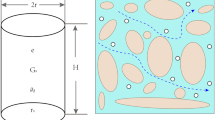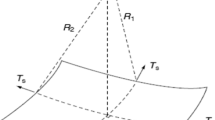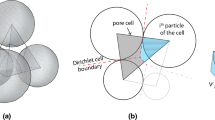Abstract
Soil is composed of particles that are condensed and bonded under an overburden pressure during burial. Obtaining the permeability coefficient of soil particles is an important issue in geological, geotechnical and hydraulic engineering. The permeability coefficient has been traditionally obtained by fitting data based on the particle size gradient and soil porosity. However, it is difficult to measure soil porosity, sample at certain depths and maintain the original pressure while sampling in the field and performing tests in the laboratory. The complicated nature of the experimental method results in considerable uncertainty regarding the accuracy of the permeability coefficient. In this paper, soil particles bonded by the force of gravity are modeled, with different pressures at different depths. Permeable soils form at certain depths, and the macroscopic permeability coefficient of the soil is obtained via seepage calculations. A relationship between the upper pressure and the permeability coefficient is established to remove the dependence on the porosity, which is an intermediate coupling parameter between soil particles and seepage. The results show that the modeled permeability coefficient is consistent with the results of previous models, and the permeability coefficient decreases with increasing depth. Thus, the proposed model of soil particle penetration can be directly used to calculate the permeability coefficient.









Similar content being viewed by others
References
Armstrong, A.C., Youngs, E.G., Arrowsmith, R.: Modeling water-table movement in drained soils with depth-dependent hydraulic conductivity. Agric. Water Manag. 20(2), 101–108 (1991)
Bakshevskaya, V.A., Pozdnyakov, S.P.: Methods of modeling hydraulic heterogeneity of sedimentary formations. Water Resour. 40(7), 667–775 (2013)
Barreto, D., O’Sullivan, C.: The influence of inter-particle friction and the intermediate stress ratio on soil response under generalised stress conditions. Granul. Matter 14(4), 505–521 (2012)
Brackbill, T.P., Kandlikar, S.G., ASME: Effect of Triangular Roughness Elements on Pressure Drop and Laminar–Turbulent Transition in Microchannels and Minichannels. Amer Soc Mechanical Engineers, New York (2006)
Brocca, L., Melone, F., Moramarco, T., Morbidelli, R.: Soil moisture temporal stability over experimental areas in Central Italy. Geoderma 148(3–4), 364–374 (2009)
Brocca, L., Tarpanelli, A., Moramarco, T., Melone, F., Ratto, S.M., Cauduro, M., Ferraris, S., Berni, N., Ponziani, F., Wagner, W., Melzer, T.: Soil moisture estimation in alpine catchments through modeling and satellite observations. Vadose Zone J. 12(3), 10 (2013)
Chaussard, E., Burgmann, R., Shirzaei, M., Fielding, E.J., Baker, B.: Predictability of hydraulic head changes and characterization of aquifer-system and fault properties from InSAR-derived ground deformation. J. Geophys. Res. Solid Earth 119(8), 6572–6590 (2014)
Davis, S.N., Turk, L.J.: Optimum depth of wells in crystalline rocks. Groundwater 2(2), 6–11 (1964)
Dong, W., Chen, X., Wang, Z., Ou, G., Liu, C.: Comparison of vertical hydraulic conductivity in a streambed-point bar system of a gaining stream. J. Hydrol. 450–451(15), 9–16 (2012)
Earnest, E., Boutt, D.: Investigating the role of hydromechanical coupling on flow and transport in shallow fractured-rock aquifers. Hydrogeol. J. 22(7), 1573–1591 (2014)
Figueiredo, B., Tsang, C.F., Rutqvist, J., Niemi, A.: A study of changes in deep fractured rock permeability due to coupled hydro-mechanical effects. Int. J. Rock Mech. Min. Sci. 79, 70–85 (2015)
Jabro, J.D.: Estimation of saturated hydraulic conductivity of soils from particle-size distribution and bulk-density data. Trans. ASAE 35(2), 557–560 (1992)
Jayawardane, N.S.: Prediction of unsaturated hydraulic conductivity changes of a loamy soil in different salt-solutions by using the equivalent salt-solutions concept. Aust. J. Soil Res. 30(5), 565–571 (1992)
Jayawardane, N.S., Blackwell, P.S.: Relationship between equivalent salt solution series of different soils. J. Soil Sci. 42(1), 95–102 (1991)
Ma, R., Shi, J., Zhang, Y., Sun, L.: Variation of hydraulic conductivity with depth in the North China plain. Arab. J. Geosci. 9(10), 1–13 (2016)
Maftei, C., Barbulescu, A.: Modeling the relation between the hydraulic conductivity and the depth. Paper presented at the mathematical modelling of environmental and life sciences problems (2006)
Mathur, S.P., Levesque, M.: Negative effect of depth on saturated hydraulic conductivity of histosols. Soil Sci. 140(6), 462–466 (1985)
Meyerhoff, S.B., Maxwell, R.M.: Quantifying the effects of subsurface heterogeneity on hillslope runoff using a stochastic approach. Hydrogeol. J. 19(8), 1515–1530 (2011)
Min, L., Yu, J., Liu, C., Zhu, J., Wang, P.: The spatial variability of streambed vertical hydraulic conductivity in an intermittent river, northwestern China. Environ. Earth Sci. 69(3), 873–883 (2013)
Naff, R.L., Vecchia, A.V.: Depth-averaging effects on hydraulic-head for media with stochastic hydraulic conductivity. Water Resour. Res. 23(4), 561–570 (1987)
Rabbani, A., Jamshidi, S.: Specific surface and porosity relationship for sandstones for prediction of permeability. Int. J. Rock Mech. Min. Sci. 71, 25–32 (2014)
Reitsma, S., Kueper, B.H.: Laboratory measurement of capillary–pressure saturation relationships in a rock fracture. Water Resour. Res. 30(4), 865–878 (1994)
Rienzner, M., Gandolfi, C.: Investigation of spatial and temporal variability of saturated soil hydraulic conductivity at the field-scale. Soil Tillage Res. 135, 28–40 (2014)
Rosas, J., Lopez, O., Missimer, T.M., Coulibaly, K.M., Dehwah, A.H.A., Sesler, K., Lujan, L.R., Mantilla, D.: Determination of hydraulic conductivity from grain-size distribution for different depositional environments. Groundwater 52(3), 399–413 (2014)
Rose, C., Stern, W., Drummond, J.: Determination of hydraulic conductivity as a function of depth and water content for soil in situ. Soil Res. 3(1), 1–9 (1965)
Rutqvist, J.: Fractured rock stress–permeability relationships from in situ data and effects of temperature and chemical–mechanical couplings. Geofluids 15(1–2), 48–66 (2015)
Saar, M.O., Manga, M.: Depth dependence of permeability in the Oregon Cascades inferred from hydrogeologic, thermal, seismic, and magmatic modeling constraints. J. Geophys. Res. Solid Earth 109(B4), 229–245 (2004)
Sakata, Y., Ikeda, R.: Depth dependence and exponential models of permeability in alluvial-fan gravel deposits. Hydrogeol. J. 21(4), 773–786 (2013)
Welch, L.A., Allen, D.M.: Hydraulic conductivity characteristics in mountains and implications for conceptualizing bedrock groundwater flow. Hydrogeol. J. 22(5), 1003–1026 (2014)
Youngs, E.G.: Horizontal seepage through unconfined aquifers with hydraulic conductivity varying with depth. J. Hydrol. 3(3–4), 283–296 (1965)
Youngs, E.G.: Steady state flow around wells in aquifers with hydraulic conductivity varying with depth. Water Resour. Res. 7(5), 1366–1368 (1971)
Zhang, L., Franklin, J.A.: Prediction of water flow into rock tunnels: an analytical solution assuming an hydraulic conductivity gradient. Int. J. Rock Mech. Min. Sci. Geomech. Abstr. 30(1), 37–46 (1993)
Zhao, P., Shao, M., Wang, T.: Spatial distributions of soil surface-layer saturated hydraulic conductivity and controlling factors on dam farmlands. Water Resour. Manag. 24(10), 2247–2266 (2010)
Funding
Funding was provided by Fundamental Research Funds for the Central Universities (Grant No. 2652017164).
Author information
Authors and Affiliations
Corresponding author
Ethics declarations
Conflict of interest
The author declares that he has no conflict of interest.
Rights and permissions
About this article
Cite this article
Sun, J. Permeability of Particle Soils Under Soil Pressure. Transp Porous Med 123, 257–270 (2018). https://doi.org/10.1007/s11242-018-1038-x
Received:
Accepted:
Published:
Issue Date:
DOI: https://doi.org/10.1007/s11242-018-1038-x




